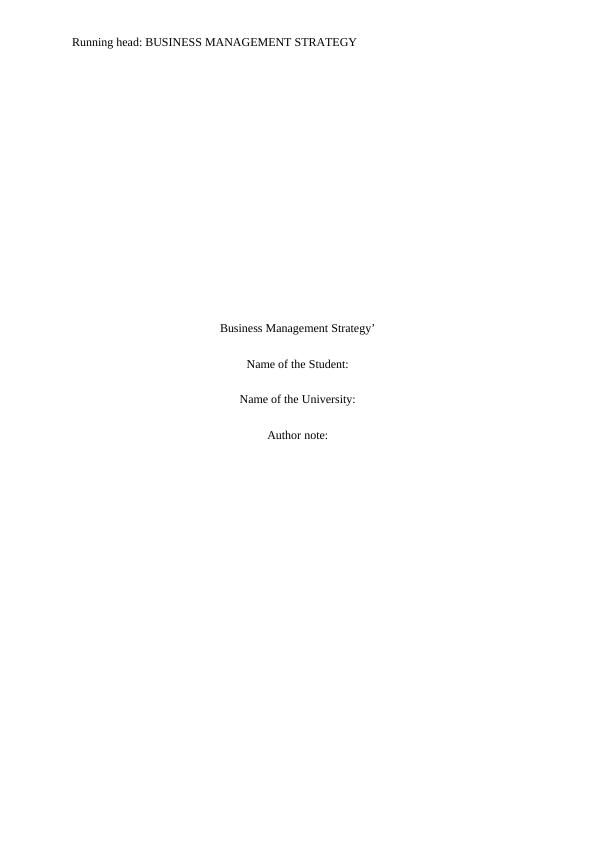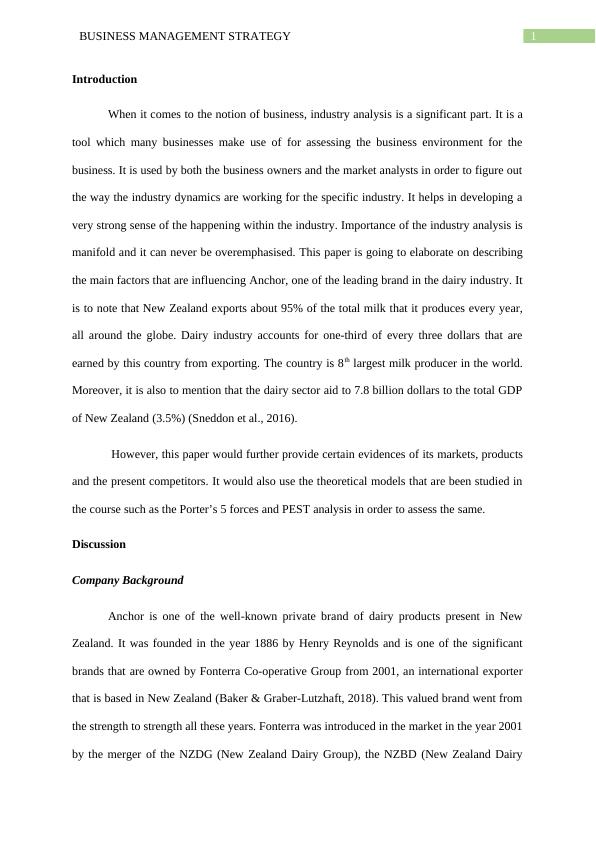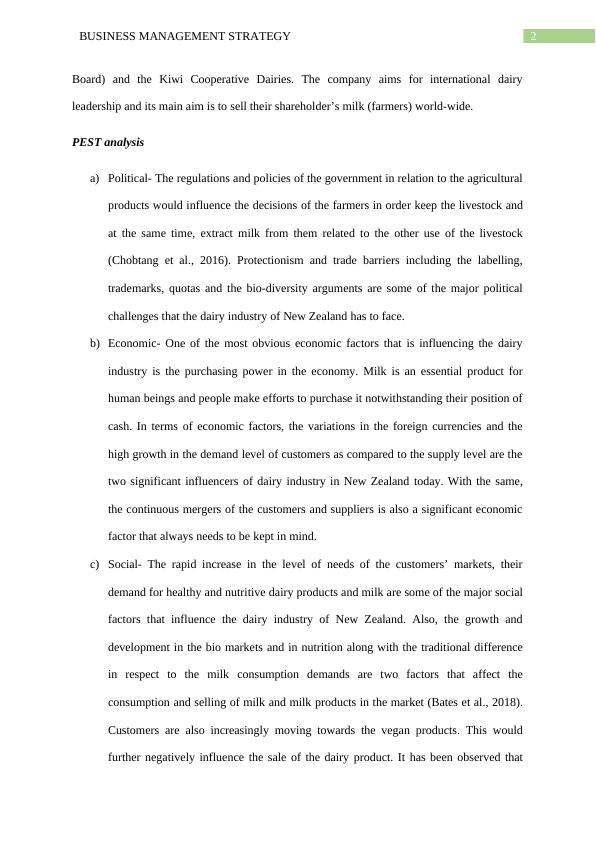Business Management Strategy
Added on 2023-04-05
11 Pages1960 Words425 Views
Running head: BUSINESS MANAGEMENT STRATEGY
Business Management Strategy’
Name of the Student:
Name of the University:
Author note:
Business Management Strategy’
Name of the Student:
Name of the University:
Author note:

1BUSINESS MANAGEMENT STRATEGY
Introduction
When it comes to the notion of business, industry analysis is a significant part. It is a
tool which many businesses make use of for assessing the business environment for the
business. It is used by both the business owners and the market analysts in order to figure out
the way the industry dynamics are working for the specific industry. It helps in developing a
very strong sense of the happening within the industry. Importance of the industry analysis is
manifold and it can never be overemphasised. This paper is going to elaborate on describing
the main factors that are influencing Anchor, one of the leading brand in the dairy industry. It
is to note that New Zealand exports about 95% of the total milk that it produces every year,
all around the globe. Dairy industry accounts for one-third of every three dollars that are
earned by this country from exporting. The country is 8th largest milk producer in the world.
Moreover, it is also to mention that the dairy sector aid to 7.8 billion dollars to the total GDP
of New Zealand (3.5%) (Sneddon et al., 2016).
However, this paper would further provide certain evidences of its markets, products
and the present competitors. It would also use the theoretical models that are been studied in
the course such as the Porter’s 5 forces and PEST analysis in order to assess the same.
Discussion
Company Background
Anchor is one of the well-known private brand of dairy products present in New
Zealand. It was founded in the year 1886 by Henry Reynolds and is one of the significant
brands that are owned by Fonterra Co-operative Group from 2001, an international exporter
that is based in New Zealand (Baker & Graber-Lutzhaft, 2018). This valued brand went from
the strength to strength all these years. Fonterra was introduced in the market in the year 2001
by the merger of the NZDG (New Zealand Dairy Group), the NZBD (New Zealand Dairy
Introduction
When it comes to the notion of business, industry analysis is a significant part. It is a
tool which many businesses make use of for assessing the business environment for the
business. It is used by both the business owners and the market analysts in order to figure out
the way the industry dynamics are working for the specific industry. It helps in developing a
very strong sense of the happening within the industry. Importance of the industry analysis is
manifold and it can never be overemphasised. This paper is going to elaborate on describing
the main factors that are influencing Anchor, one of the leading brand in the dairy industry. It
is to note that New Zealand exports about 95% of the total milk that it produces every year,
all around the globe. Dairy industry accounts for one-third of every three dollars that are
earned by this country from exporting. The country is 8th largest milk producer in the world.
Moreover, it is also to mention that the dairy sector aid to 7.8 billion dollars to the total GDP
of New Zealand (3.5%) (Sneddon et al., 2016).
However, this paper would further provide certain evidences of its markets, products
and the present competitors. It would also use the theoretical models that are been studied in
the course such as the Porter’s 5 forces and PEST analysis in order to assess the same.
Discussion
Company Background
Anchor is one of the well-known private brand of dairy products present in New
Zealand. It was founded in the year 1886 by Henry Reynolds and is one of the significant
brands that are owned by Fonterra Co-operative Group from 2001, an international exporter
that is based in New Zealand (Baker & Graber-Lutzhaft, 2018). This valued brand went from
the strength to strength all these years. Fonterra was introduced in the market in the year 2001
by the merger of the NZDG (New Zealand Dairy Group), the NZBD (New Zealand Dairy

2BUSINESS MANAGEMENT STRATEGY
Board) and the Kiwi Cooperative Dairies. The company aims for international dairy
leadership and its main aim is to sell their shareholder’s milk (farmers) world-wide.
PEST analysis
a) Political- The regulations and policies of the government in relation to the agricultural
products would influence the decisions of the farmers in order keep the livestock and
at the same time, extract milk from them related to the other use of the livestock
(Chobtang et al., 2016). Protectionism and trade barriers including the labelling,
trademarks, quotas and the bio-diversity arguments are some of the major political
challenges that the dairy industry of New Zealand has to face.
b) Economic- One of the most obvious economic factors that is influencing the dairy
industry is the purchasing power in the economy. Milk is an essential product for
human beings and people make efforts to purchase it notwithstanding their position of
cash. In terms of economic factors, the variations in the foreign currencies and the
high growth in the demand level of customers as compared to the supply level are the
two significant influencers of dairy industry in New Zealand today. With the same,
the continuous mergers of the customers and suppliers is also a significant economic
factor that always needs to be kept in mind.
c) Social- The rapid increase in the level of needs of the customers’ markets, their
demand for healthy and nutritive dairy products and milk are some of the major social
factors that influence the dairy industry of New Zealand. Also, the growth and
development in the bio markets and in nutrition along with the traditional difference
in respect to the milk consumption demands are two factors that affect the
consumption and selling of milk and milk products in the market (Bates et al., 2018).
Customers are also increasingly moving towards the vegan products. This would
further negatively influence the sale of the dairy product. It has been observed that
Board) and the Kiwi Cooperative Dairies. The company aims for international dairy
leadership and its main aim is to sell their shareholder’s milk (farmers) world-wide.
PEST analysis
a) Political- The regulations and policies of the government in relation to the agricultural
products would influence the decisions of the farmers in order keep the livestock and
at the same time, extract milk from them related to the other use of the livestock
(Chobtang et al., 2016). Protectionism and trade barriers including the labelling,
trademarks, quotas and the bio-diversity arguments are some of the major political
challenges that the dairy industry of New Zealand has to face.
b) Economic- One of the most obvious economic factors that is influencing the dairy
industry is the purchasing power in the economy. Milk is an essential product for
human beings and people make efforts to purchase it notwithstanding their position of
cash. In terms of economic factors, the variations in the foreign currencies and the
high growth in the demand level of customers as compared to the supply level are the
two significant influencers of dairy industry in New Zealand today. With the same,
the continuous mergers of the customers and suppliers is also a significant economic
factor that always needs to be kept in mind.
c) Social- The rapid increase in the level of needs of the customers’ markets, their
demand for healthy and nutritive dairy products and milk are some of the major social
factors that influence the dairy industry of New Zealand. Also, the growth and
development in the bio markets and in nutrition along with the traditional difference
in respect to the milk consumption demands are two factors that affect the
consumption and selling of milk and milk products in the market (Bates et al., 2018).
Customers are also increasingly moving towards the vegan products. This would
further negatively influence the sale of the dairy product. It has been observed that

3BUSINESS MANAGEMENT STRATEGY
vegans always make it a point that all the animal products are shunned, whether it be
eggs or milk. As such a lifestyle is gaining more followers, the sale of the dairy
products are decreasing and this influencing the dairy industry again. Furthermore, the
attitude of people towards obesity can also influence the sale of dairy products world-
wide.
d) Technological- The regular change in the technology is influencing the product
production and at the same time, in order to upgrade the quantity and the quality in
the line of products, it is very importance to become well aware of the new innovative
technology that is coming up next in the market (Pawson, 2018). New technologies
always helps in bringing down the cost of production for the companies. In case of
dairy companies, indirect cooling and heating system is necessary for one other, there
is a requirement of new technology for fewer trucks that are necessary for
transportation of the same quantity of milk.
Porter’s Five Forces
a) Threat of new entry-
a. New Zealand has a de-regulated structure of market and the low cost market
have the potential to attract new entrants as a base for the export oriented
processing and supplying (Polemis, 2016).
b. New entrants give a tough competition to Anchor in New Zealand and this
could be a high risk for it in the coming future that it was ever in the past
years. At the present structure, they make it very easy for the new entrants for
taking part in the dealership of dairy farmers by caring high worth share on the
fair value share that is not linked to the added value to the elements of the
price of the milk (Mawdsley et al., 2018).
vegans always make it a point that all the animal products are shunned, whether it be
eggs or milk. As such a lifestyle is gaining more followers, the sale of the dairy
products are decreasing and this influencing the dairy industry again. Furthermore, the
attitude of people towards obesity can also influence the sale of dairy products world-
wide.
d) Technological- The regular change in the technology is influencing the product
production and at the same time, in order to upgrade the quantity and the quality in
the line of products, it is very importance to become well aware of the new innovative
technology that is coming up next in the market (Pawson, 2018). New technologies
always helps in bringing down the cost of production for the companies. In case of
dairy companies, indirect cooling and heating system is necessary for one other, there
is a requirement of new technology for fewer trucks that are necessary for
transportation of the same quantity of milk.
Porter’s Five Forces
a) Threat of new entry-
a. New Zealand has a de-regulated structure of market and the low cost market
have the potential to attract new entrants as a base for the export oriented
processing and supplying (Polemis, 2016).
b. New entrants give a tough competition to Anchor in New Zealand and this
could be a high risk for it in the coming future that it was ever in the past
years. At the present structure, they make it very easy for the new entrants for
taking part in the dealership of dairy farmers by caring high worth share on the
fair value share that is not linked to the added value to the elements of the
price of the milk (Mawdsley et al., 2018).

End of preview
Want to access all the pages? Upload your documents or become a member.
Related Documents
Situation Analysis of Fonterra: SWOT, PESTLE, Competitor Analysislg...
|14
|3014
|474
Strategic Management Issues in Fonterralg...
|9
|2299
|426
Strategic Management: Company Background, Competitors, and Segmentationlg...
|9
|1711
|354
Sustainable Practice and Operations Management for Fonterralg...
|18
|4451
|136
Strategic Management of Fonterra: Analysis and Recommendationslg...
|11
|2841
|2
Management of Organizational Environment Assignmentlg...
|12
|3058
|130
